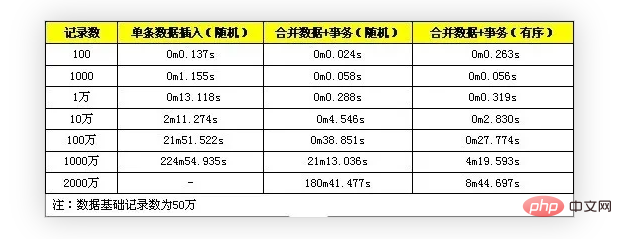详解MySQL批量SQL插入的性能优化
mysql教程栏目介绍批量SQL插入

推荐(免费):mysql教程
对于一些数据量较大的系统,数据库面临的问题除了查询效率低下,还有就是数据入库时间长。特别像报表系统,每天花费在数据导入上的时间可能会长达几个小时或十几个小时之久。因此,优化数据库插入性能是很有意义的。
一条SQL语句插入多条数据
INSERT INTO `insert_table` (`datetime`, `uid`, `content`, `type`)
VALUES ('0', 'userid_0', 'content_0', 0);INSERT INTO `insert_table` (`datetime`, `uid`, `content`, `type`)
VALUES ('1', 'userid_1', 'content_1', 1);INSERT INTO `insert_table` (`datetime`, `uid`, `content`, `type`)
VALUES ('0', 'userid_0', 'content_0', 0), ('1', 'userid_1', 'content_1', 1);- 第二种SQL执行效率高的主要原因是合并后日志量[mysql的binlog和InnoDB的事务让日志]减少了,降低日志刷盘的数据量和频率,从而提高效率。
- 通过合并SQL语句,同时也能减少SQL语句解析的次数,减少网络传输的IO。
测试对比数据,分别是单条数据的导入与转换成一条SQL语句进行导入。
在事务中进行插入处理
START TRANSACTION;INSERT INTO `insert_table` (`datetime`, `uid`, `content`, `type`) VALUES ('0', 'userid_0', 'content_0', 0);INSERT INTO `insert_table` (`datetime`, `uid`, `content`, `type`) VALUES ('1', 'userid_1', 'content_1', 1);...COMMIT;- 使用事务可以提高数据的插入效率,这是因为进行一个insert操作时,MySQL内部都会建立一个事务,在事务内才进行真正插入处理操作。
- 通过使用事务减少创建事务的消耗,所有插入都在执行后才进行提交操作
测试对比数据,分笔试不适用事务和使用事务操作

数据有序插入
数据有序的插入是插入记录在主键上的有序排序
INSERT INTO `insert_table` (`datetime`, `uid`, `content`, `type`) VALUES ('1', 'userid_1', 'content_1', 1);INSERT INTO `insert_table` (`datetime`, `uid`, `content`, `type`) VALUES ('0', 'userid_0', 'content_0', 0);INSERT INTO `insert_table` (`datetime`, `uid`, `content`, `type`) VALUES ('2', 'userid_2', 'content_2',2);INSERT INTO `insert_table` (`datetime`, `uid`, `content`, `type`) VALUES ('0', 'userid_0', 'content_0', 0);INSERT INTO `insert_table` (`datetime`, `uid`, `content`, `type`) VALUES ('1', 'userid_1', 'content_1', 1);INSERT INTO `insert_table` (`datetime`, `uid`, `content`, `type`) VALUES ('2', 'userid_2', 'content_2',2);- 由于数据库插入时,需要维护索引数据,无需的记录会增大维护索引的成本。
参照InnoDB使用的B+tree索引,如果每次插入记录都在索引的最后面,索引的定位效率很高,并且对索引调整较少;如果插入的记录在索引中间,需要B+tree进行分裂合并等处理,会消耗比较多计算资源,并且插入记录的索引定位效率会下降,数据量较大时会有频繁的磁盘操作。
测试对比数据,随机数据与顺序数据的性能对比

先删除索引,插入完成后重建索引
性能综合测试

- 合并数据+事务的方法在较少数据量时,性能提升很明显,数据量较大时,性能急剧下降,这是由于此时数据量超过了innodb_buffer的容量,每次定位索引涉及较多的磁盘读写操作,性能下降较快。
- 合并数据+事务+有序的方法在数据量达到千万级以上表现依然良好,在数据量较大时,有序数据索引定位较为方便,不需要频繁对磁盘进行读写操作,可以维持较高
注意事项
SQL语句是有长度限制,在进行数据合并在同一SQL中务必不能超过SQL长度限制,通过
max_allowed_packet配置可以修改,默认1M,测试时可以修改为8M。事务需要控制大小,事物太大可能影响执行的效率。MySQL有
innodb_log_buffer_size配置项,超过这个值会把innodb的数据刷到磁盘中,这时,效率会有所下降。所以较好的做法是,在数据达到这个值前执行事务提交。
以上是详解MySQL批量SQL插入的性能优化的详细内容。更多信息请关注PHP中文网其他相关文章!

热AI工具

Undresser.AI Undress
人工智能驱动的应用程序,用于创建逼真的裸体照片

AI Clothes Remover
用于从照片中去除衣服的在线人工智能工具。

Undress AI Tool
免费脱衣服图片

Clothoff.io
AI脱衣机

AI Hentai Generator
免费生成ai无尽的。

热门文章

热工具

记事本++7.3.1
好用且免费的代码编辑器

SublimeText3汉化版
中文版,非常好用

禅工作室 13.0.1
功能强大的PHP集成开发环境

Dreamweaver CS6
视觉化网页开发工具

SublimeText3 Mac版
神级代码编辑软件(SublimeText3)

热门话题
 无法以 root 身份登录 mysql
Apr 08, 2025 pm 04:54 PM
无法以 root 身份登录 mysql
Apr 08, 2025 pm 04:54 PM
无法以 root 身份登录 MySQL 的原因主要在于权限问题、配置文件错误、密码不符、socket 文件问题或防火墙拦截。解决方法包括:检查配置文件中 bind-address 参数是否正确配置。查看 root 用户权限是否被修改或删除,并进行重置。验证密码是否准确无误,包括大小写和特殊字符。检查 socket 文件权限设置和路径。检查防火墙是否阻止了 MySQL 服务器的连接。
 mysql用户和数据库的关系
Apr 08, 2025 pm 07:15 PM
mysql用户和数据库的关系
Apr 08, 2025 pm 07:15 PM
MySQL 数据库中,用户和数据库的关系通过权限和表定义。用户拥有用户名和密码,用于访问数据库。权限通过 GRANT 命令授予,而表由 CREATE TABLE 命令创建。要建立用户和数据库之间的关系,需创建数据库、创建用户,然后授予权限。
 RDS MySQL 与 Redshift 零 ETL 集成
Apr 08, 2025 pm 07:06 PM
RDS MySQL 与 Redshift 零 ETL 集成
Apr 08, 2025 pm 07:06 PM
数据集成简化:AmazonRDSMySQL与Redshift的零ETL集成高效的数据集成是数据驱动型组织的核心。传统的ETL(提取、转换、加载)流程复杂且耗时,尤其是在将数据库(例如AmazonRDSMySQL)与数据仓库(例如Redshift)集成时。然而,AWS提供的零ETL集成方案彻底改变了这一现状,为从RDSMySQL到Redshift的数据迁移提供了简化、近乎实时的解决方案。本文将深入探讨RDSMySQL零ETL与Redshift集成,阐述其工作原理以及为数据工程师和开发者带来的优势。
 MySQL 中的查询优化对于提高数据库性能至关重要,尤其是在处理大型数据集时
Apr 08, 2025 pm 07:12 PM
MySQL 中的查询优化对于提高数据库性能至关重要,尤其是在处理大型数据集时
Apr 08, 2025 pm 07:12 PM
1.使用正确的索引索引通过减少扫描的数据量来加速数据检索select*fromemployeeswherelast_name='smith';如果多次查询表的某一列,则为该列创建索引如果您或您的应用根据条件需要来自多个列的数据,则创建复合索引2.避免选择*仅选择那些需要的列,如果您选择所有不需要的列,这只会消耗更多的服务器内存并导致服务器在高负载或频率时间下变慢例如,您的表包含诸如created_at和updated_at以及时间戳之类的列,然后避免选择*,因为它们在正常情况下不需要低效查询se
 mysql 是否更改表锁定表
Apr 08, 2025 pm 05:06 PM
mysql 是否更改表锁定表
Apr 08, 2025 pm 05:06 PM
MySQL修改表结构时,通常使用元数据锁,可能导致锁表。为了减少锁的影响,可采取以下措施:1. 使用在线DDL保持表可用;2. 分批执行复杂修改;3. 在小表或非高峰期操作;4. 使用PT-OSC工具实现更精细的控制。
 mysql 是否要付费
Apr 08, 2025 pm 05:36 PM
mysql 是否要付费
Apr 08, 2025 pm 05:36 PM
MySQL 有免费的社区版和收费的企业版。社区版可免费使用和修改,但支持有限,适合稳定性要求不高、技术能力强的应用。企业版提供全面商业支持,适合需要稳定可靠、高性能数据库且愿意为支持买单的应用。选择版本时考虑的因素包括应用关键性、预算和技术技能。没有完美的选项,只有最合适的方案,需根据具体情况谨慎选择。
 mysql 可以在 android 上运行吗
Apr 08, 2025 pm 05:03 PM
mysql 可以在 android 上运行吗
Apr 08, 2025 pm 05:03 PM
MySQL无法直接在Android上运行,但可以通过以下方法间接实现:使用轻量级数据库SQLite,由Android系统自带,无需单独服务器,资源占用小,非常适合移动设备应用。远程连接MySQL服务器,通过网络连接到远程服务器上的MySQL数据库进行数据读写,但存在网络依赖性强、安全性问题和服务器成本等缺点。
 如何针对高负载应用程序优化 MySQL 性能?
Apr 08, 2025 pm 06:03 PM
如何针对高负载应用程序优化 MySQL 性能?
Apr 08, 2025 pm 06:03 PM
MySQL数据库性能优化指南在资源密集型应用中,MySQL数据库扮演着至关重要的角色,负责管理海量事务。然而,随着应用规模的扩大,数据库性能瓶颈往往成为制约因素。本文将探讨一系列行之有效的MySQL性能优化策略,确保您的应用在高负载下依然保持高效响应。我们将结合实际案例,深入讲解索引、查询优化、数据库设计以及缓存等关键技术。1.数据库架构设计优化合理的数据库架构是MySQL性能优化的基石。以下是一些核心原则:选择合适的数据类型选择最小的、符合需求的数据类型,既能节省存储空间,又能提升数据处理速度






